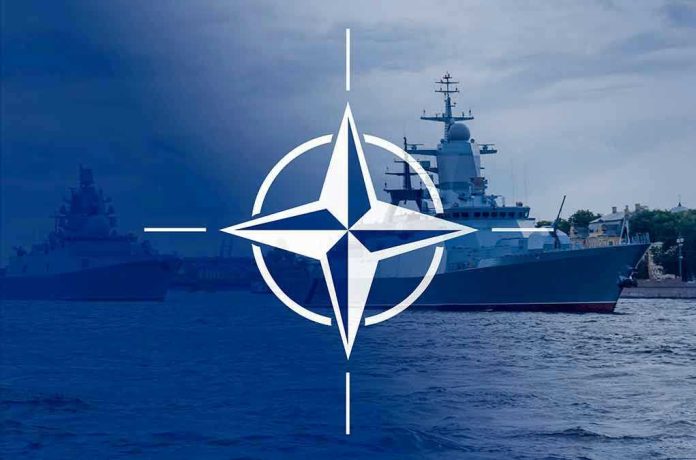
Poland’s scramble of fighter jets over Russian missile attacks on Ukraine shows just how close NATO has come to the brink—again—and the world’s supposed “leaders” still act shocked each time the bear rattles its cage.
At a Glance
- Poland and Sweden, both NATO members, scrambled fighter jets as Russia unleashed a massive missile and drone barrage on Ukraine near the Polish border.
- No violations of Polish airspace occurred, but the alerts and military mobilization highlight the ever-present danger on NATO’s eastern flank.
- Russia’s escalation tests NATO’s resolve, while Ukraine bears the brunt of the attacks and NATO nations face increased readiness demands.
- Poland’s rapid response underscores growing anxiety about spillover from the war and the need for vigilant air defense.
Poland Scrambles to Defend Its Border—Again
Overnight on July 27–28, 2025, Russia launched a jaw-dropping 324 drones and seven missiles at Ukraine, with many aimed at regions dangerously close to Poland’s border. The Polish Armed Forces, in concert with Swedish JAS 39 Gripen jets stationed on Polish soil, immediately scrambled fighter jets and put ground-based air defense on high alert. This was not some training exercise—this was the real deal, with Polish and allied pilots suiting up to defend not just their own country, but the integrity of NATO itself. Once again, NATO’s so-called “red lines” were tested—not with a dramatic invasion, but with relentless, grinding pressure right at the edges of allied territory.
The Operational Command of the Polish Armed Forces did not mince words, stating these actions were “preventive in nature and are aimed at securing airspace and protecting citizens, especially in areas adjacent to the threatened region.” The jets were scrambled, radars scanned the skies, ground crews braced for impact—and, by some miracle, no Russian missile or drone violated Polish airspace. The all-clear was given by morning, but the message was clear: the threat is never far, and NATO’s eastern members are forced to remain on a hair trigger because the world’s bad actors see nothing but opportunity in every sign of weakness.
Russia’s War Machine Tests NATO’s Patience and Resolve
Poland is no stranger to these alarms. In the past three years, the border region has seen multiple incidents of Russian missiles or debris crossing into NATO airspace. Each incident triggers diplomatic protests, military alerts, and endless reassurance from Western leaders that “all options are on the table”—yet the attacks continue, and the people living near the border are left to wonder just how many more “close calls” they’ll have to endure before a real disaster strikes. Ukrainian officials, for their part, are fed up. President Zelensky’s chief of staff, Andriy Yermak, didn’t sugarcoat it: “Russia and its satellites are also testing NATO’s response. Drones entering the airspace of the Baltic states are signals that must not be ignored.”
Officials from the Polish military and NATO command echoed the warning. This is not some isolated event—it’s a pattern. The Russians hammer Ukraine with long-range missiles and drones, often targeting infrastructure near NATO borders, daring the alliance to respond. Sweden’s participation in scrambling jets is significant; as a new NATO member, Sweden isn’t just sitting on the sidelines. Their involvement signals a new level of cohesion and readiness among allies, but also a recognition that the threat is far from theoretical. Every night of missile barrages and every morning of “no violations reported” is a reminder that the balance can tip in an instant.
Constant Vigilance, Growing Anxiety, and the Risk of Complacency
The Polish and Swedish aircraft eventually returned to regular operations, but there is no returning to “normal” for those on the front lines of this conflict. Polish border communities remain on edge, and NATO military personnel are working overtime to maintain a state of readiness that would exhaust even the best-resourced armies. Security analysts warn that Russia’s tactics are designed to erode that readiness, to create “alert fatigue,” and to lull the West into accepting constant provocation as the new normal. But every scramble, every radar ping, and every morning after brings the risk of accident—or overreaction—that could spiral into direct conflict.
This vigilance comes at a cost. Economically, cross-border trade and investment in eastern Poland are already suffering. Socially, anxiety is spreading. Politically, the demands for stronger air defense and tougher NATO deterrence are growing louder—especially with the memory of extreme leftist appeasement still fresh in the minds of many. The defense sector, meanwhile, is booming, with rapid investments in quick-reaction alert systems, radar upgrades, and integrated command structures. The message from the front lines: deterrence isn’t cheap, but complacency is unaffordable.
Sources:
UPI: Ukraine, NATO jets scramble as Russia launches massive drone, missile attack
Mezha: Poland boosts air defense amid Russian missile attacks on Ukraine
Caliber.az: Poland raised overnight air alert amid Russian missile threat
Al Arabiya: Poland scrambles aircraft after Russia launches missiles attack on Ukraine









